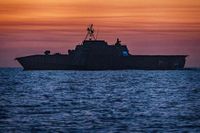The United States Navy has announced plans to construct two new repair and maintenance facilities for Philippine military vessels in the western Philippines, a strategically vital region facing the contested South China Sea. The announcement, made by the U.S. Embassy in Manila on July 16, 2025, underscores the deepening defense cooperation between the two treaty allies amid rising tensions with China over territorial claims in the region.
One of the facilities is set to be built in the coastal town of Quezon in Palawan province, approximately 240 kilometers east of the Second Thomas Shoal, part of the Spratly archipelago. This area is a notable flashpoint where Philippine forces maintain a small detachment aboard the grounded BRP Sierra Madre, a World War II-era warship that has symbolized Philippine sovereignty since 1999. The shoal has been the site of repeated confrontations with Chinese vessels, including aggressive actions by the China Coast Guard, which have escalated concerns about maritime security in the area.
The second facility will be located at the Philippine Navy's existing Oyster Bay naval detachment, also in Palawan but about 130 kilometers north of Quezon. Oyster Bay serves as a crucial logistical base for the Armed Forces of the Philippines’ rotation and resupply missions to contested features like Ayungin Shoal, another hotspot where Philippine and Chinese forces have clashed. The U.S. Embassy emphasized that these facilities are not military bases but repair hubs designed to support Philippine naval operations.
According to the U.S. government's contracting website, Sam.gov, the facilities will provide repair and maintenance capabilities for a variety of Philippine vessels, including 7.32-meter (24-foot) watercraft such as rigid-hull inflatable boats (RHIBs) and other smaller conventional boats. These vessels are essential for patrols, surveillance, and resupply missions in shallow and contested waters where larger ships cannot operate effectively. Retired Philippine admiral and military analyst Rommel Jude Ong noted that the facilities could also support smaller rubber boats used in the resupply of occupied features, highlighting their tactical importance.
The U.S. Embassy in Manila stated that the projects align with the 1951 Mutual Defense Treaty between the United States and the Philippines, aiming to maintain a "free, open and resilient Indo-Pacific." The embassy further clarified that all military activities connected to these facilities are conducted in full coordination with Philippine authorities, reinforcing the sovereign control of the host nation.
Palawan province holds strategic significance as the headquarters of the Philippine military’s Western Command, which deploys naval patrol vessels, surveillance ships, and aircraft to protect the country’s maritime interests. The South China Sea, claimed almost entirely by Beijing under the controversial "nine-dash line," overlaps with the recognized maritime boundaries of several countries, including the Philippines, Vietnam, Malaysia, Brunei, and Taiwan. The area is a major global waterway and a persistent source of regional friction, particularly between the United States and China.
The construction of these facilities is part of a broader U.S. effort to establish "low-footprint deterrence" in the region. By enhancing the Philippine Navy’s ability to repair and maintain its small vessels locally, the U.S. aims to improve rapid response capabilities in the event of conflict or harassment at sea. The U.S. Embassy acknowledged that the Oyster Bay facility will improve repair efforts for Philippine boats stationed there, which in turn strengthens regional military capabilities and subtly expands the U.S. military presence.
These developments come amid a backdrop of heightened tensions, including a notable incident on June 17, 2024, when China Coast Guard personnel blocked and attacked Philippine Navy-contracted boats during a resupply mission to Ayungin Shoal. The confrontation involved the use of tear gas, sirens, and even bladed weapons, resulting in injuries to a Filipino sailor and the looting of supplies. Such incidents underscore the precarious nature of Philippine operations in disputed waters and the urgent need for enhanced logistical support.
In response to these challenges, the U.S. has also constructed warehouses, barracks, and other facilities in nine Philippine military camps under the 2014 Enhanced Defense Cooperation Agreement (EDCA). These sites allow rotating American forces to stay and store weapons, bolstering joint readiness and interoperability. While Oyster Bay is not formally an EDCA site, the new repair facility reflects the expanding scope of U.S.-Philippine defense collaboration.
Analysts like Bao Yinan, an associate research fellow at the Huayang Centre for Maritime Cooperation and Ocean Governance in Hainan, interpret the facilities as primarily intended to enhance the combat capabilities of the Philippine Navy, thereby strengthening its ability to "confront" or "counter" China. The U.S. may also be positioning itself to facilitate shared use of Philippine naval infrastructure, further deepening military ties.
Locals and officials in Palawan have expressed cautious optimism about the new facilities. Palawan Provincial Board Member Ferdinand Zaballa described the repair hub as a "vital addition to our defense infrastructure," emphasizing its role in safeguarding both military personnel and fisherfolk who have faced harassment at sea. He highlighted the importance of deterrence in protecting the freedom of local communities and reinforcing Philippine sovereignty.
Celso Magdayao, a fisherman from Barangay Macarascas near Oyster Bay, remarked, "If it helps strengthen our defense, then that’s fine. But it should be clear – we must remain in control, not another country." This sentiment reflects the broader public desire for sovereignty and autonomy even as the Philippines deepens its strategic partnership with the United States.
Since President Ferdinand Marcos Jr. took office in 2022, U.S.-Philippine defense ties have grown significantly. The U.S. has gained expanded access to Philippine military bases and deployed weapons to the country, actions that have drawn ire from Beijing. China continues to reject the 2016 arbitral tribunal ruling that invalidated its expansive claims in the South China Sea, maintaining a firm stance against what it views as foreign interference.
In 2024, then-U.S. Defense Secretary Lloyd Austin III acknowledged the existence of "US Task Force Ayungin" based in Palawan, which provides support functions such as intelligence, surveillance, and reconnaissance to assist Philippine operations. Although the U.S. offered to escort Philippine supply missions after the 2024 resupply incident, the Armed Forces of the Philippines emphasized autonomy, with AFP Chief of Staff General Romeo Brawner Jr. stating, "We will depend on ourselves first, and we will try to exhaust all options before asking for help."
Overall, the planned construction of these repair facilities represents a strategic move to bolster the Philippines’ maritime capabilities and enhance regional security amid a complex geopolitical landscape. By providing vital infrastructure close to flashpoints in the South China Sea, the United States and the Philippines are signaling their commitment to upholding a rules-based order and deterring further escalation in one of the world’s most contested waterways.






